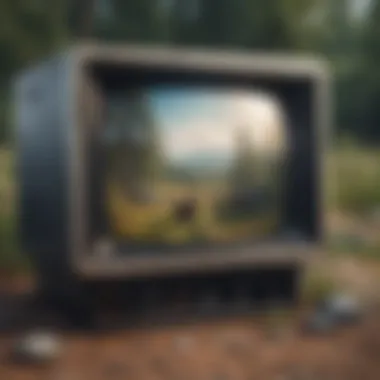Discover Sustainable Ways to Dispose of CRT TVs Responsibly


Overview of the Topic
Cathode Ray Tube (CRT) TVs have posed a significant environmental concern due to their hazardous materials, such as lead and mercury, which can seep into the soil and water sources if not disposed of properly. These older television sets, although now outdated by newer technologies, continue to impact the environment if not discarded responsibly. Understanding the proper disposal methods for CRT TVs is crucial for reducing the environmental footprint associated with electronic waste.
Current Status and Challenges
The current state of CRT TV disposal is alarming, with many of these devices ending up in landfills or incinerators, leading to toxic chemicals leaching into the environment. Challenges include the lack of awareness among the general public about the harmful effects of improper CRT TV disposal and the limited availability of recycling facilities equipped to handle these outdated electronics safely.
Sustainable Solutions
To address the growing issue of CRT TV disposal, sustainable solutions have been developed. One such approach is through e-waste recycling centers that specialize in handling electronic devices like CRT TVs. These centers ensure that hazardous materials are extracted and disposed of correctly, while valuable components are salvaged for reuse, promoting a circular economy. The integration of advanced technologies in e-waste recycling processes has improved the efficiency and safety of handling CRT TVs.
Impact and Importance
The impact of irresponsible CRT TV disposal extends beyond environmental degradation to human health risks and resource depletion. The proper disposal of CRT TVs contributes to conserving natural resources, reducing pollution, and safeguarding ecosystems. Emphasizing the importance of recycling CRT TVs not only mitigates environmental harm but also sets a precedent for sustainable waste management practices for future generations to follow.
Understanding CRT TVs
In this article, we delve into the intricate world of CRT TVs, shedding light on their significance in the realm of electronic waste management. Understanding CRT TVs is vital for those aiming to dispose of these devices responsibly. By comprehending the composition and functionality of CRT technology, individuals can make informed decisions regarding their disposal methods. This section will elucidate the environmental implications of CRT TVs and the importance of adopting eco-friendly practices in electronic waste disposal.
What are CRT TVs?
Description of CRT technology
The Description of CRT technology encompasses the fundamental workings of Cathode Ray Tube televisions. This technology relies on electron beams to illuminate phosphors, producing images on the screen. The key characteristic of Description of CRT technology lies in its utilization of analog signals to create visual content. While CRT technology has been overshadowed by modern flat-screen alternatives, its distinctive feature of delivering deep and vibrant colors remains unmatched. Despite its bulkiness, the nostalgic appeal of CRT TVs continues to resonate with enthusiasts seeking authentic viewing experiences.


Issues related to CRT disposal
When exploring Issues related to CRT disposal, one confronts the challenges posed by the environmentally harmful components within CRT TVs. The key characteristic of Issues related to CRT disposal is the presence of hazardous materials like lead and mercury, necessitating specialized handling during disposal. The unique feature of Issues related to CRT disposal lies in the potential environmental harm caused by improper disposal practices. Understanding these issues is crucial for mitigating the adverse effects of CRT TVs on ecosystems and human health.
Environmental Impact of CRT TVs
Toxic components in CRTs
Discussing Toxic components in CRTs delves into the hazardous substances present within CRT TVs. The key characteristic of Toxic components in CRTs is the inclusion of leaded glass and toxic chemicals in the manufacturing of CRT screens. This aspect contributes significantly to the overall toxicity of CRT TVs, requiring careful handling and disposal procedures. The unique feature of Toxic components in CRTs is their detrimental impact on environmental and human well-being, emphasizing the need for responsible e-waste management practices.
Impact on soil and water
The Impact on soil and water stemming from CRT disposal highlights the potential consequences of improper electronic waste handling. CRT TVs contain substances that, if leached into soil or water bodies, can lead to contamination and ecological damage. The key characteristic of Impact on soil and water is the risk of heavy metals seeping into the environment, affecting both terrestrial and aquatic ecosystems. Understanding this impact underscores the urgency of adopting sustainable disposal methods to safeguard our natural resources and biodiversity.
Safe Disposal Methods
Safe disposal methods play a vital role in environmental conservation efforts when it comes to CRT TVs. Understanding the significance of disposing of these devices properly is crucial in minimizing the negative impacts they can have on the environment. By following safe disposal methods, individuals can contribute to reducing e-waste pollution and protecting our ecosystems for future generations. Adopting responsible disposal practices ensures that hazardous components within CRT TVs do not end up in landfills or harm the surrounding ecosystem. Properly disposing of CRT TVs is not only about complying with regulations but also about taking proactive steps towards a sustainable future.
Local Recycling Centers
Locating nearby recycling facilities
Locating nearby recycling facilities is an essential aspect of the safe disposal of CRT TVs. By identifying and utilizing local recycling centers, individuals can conveniently and responsibly get rid of their outdated electronic devices. These facilities offer a designated space where CRT TVs can be dropped off for proper recycling, reducing the chances of them ending up in landfills. Locating nearby recycling facilities not only promotes environmental sustainability but also supports the local economy by creating green job opportunities within the recycling industry. Choosing to make use of these facilities demonstrates a commitment to environmental stewardship and waste reduction efforts.
Proper preparation for drop-off


Properly preparing CRT TVs for drop-off at recycling centers is a key step in ensuring their safe disposal. Before taking the device to a recycling facility, it is important to disconnect all power sources and ensure that the TV is ready for transportation. Proper preparation includes securely packing the CRT TV to prevent any damage during transit and adhering to any specific guidelines set by the recycling center. By following proper preparation techniques, individuals can streamline the disposal process and contribute to efficient e-waste management practices. Taking the time to prepare CRT TVs for drop-off demonstrates a commitment to responsible recycling and environmental preservation.
Manufacturer Take-Back Programs
Inquiries with TV manufacturers
Engaging in inquiries with TV manufacturers about their take-back programs is a valuable practice when considering the disposal of CRT TVs. Many manufacturers offer recycling initiatives that allow consumers to return their old devices for proper disposal. By reaching out to manufacturers, individuals can gain insight into how to participate in these programs and contribute to sustainable waste management practices. Inquiries with TV manufacturers provide individuals with guidance on the best steps to take when it comes to responsibly disposing of their CRT TVs, fostering a culture of extended producer responsibility within the electronics industry.
Guidelines for returning old CRT TVs
Following guidelines set by manufacturers for returning old CRT TVs is essential in ensuring the success of take-back programs. These guidelines often detail the specific procedures for packaging and returning the device, making it easy for consumers to participate in recycling initiatives. By adhering to the guidelines provided, individuals can navigate the process smoothly and maximize the environmental benefits of returning their old CRT TVs. Guidelines for returning old CRT TVs streamline the disposal process, making it accessible and convenient for consumers looking to dispose of their electronic devices responsibly.
E-Waste Recycling Events
Participating in community recycling drives
Community recycling drives provide an excellent opportunity for individuals to dispose of their CRT TVs in a sustainable manner. By participating in these events, community members can come together to recycle electronic waste, including CRT devices, effectively reducing the overall e-waste footprint. Community recycling drives facilitate the proper disposal of electronic devices and raise awareness about the importance of responsible recycling practices. By joining these events, individuals can contribute to a cleaner environment and support initiatives aimed at reducing the environmental impact of electronic waste.
Notifying about CRT TV disposal needs
Notifying relevant organizations about CRT TV disposal needs is a proactive step towards responsible e-waste management. By informing local authorities or recycling centers about the need to dispose of CRT TVs, individuals can seek guidance on the best disposal options available to them. Notifying about CRT TV disposal needs helps in coordinating efforts to handle electronic waste efficiently and ensures that these devices are recycled or disposed of correctly. By communicating their disposal needs, individuals can contribute to the larger goal of reducing e-waste pollution and promoting sustainable waste management practices.
DIY Disposal Considerations
In this article, understanding the significance of DIY disposal considerations is paramount in addressing the responsible disposal of CRT TVs. DIY disposal not only allows individuals to take direct control over the process but also promotes sustainability by ensuring proper handling of hazardous electronic waste. DIY methods also serve as an educational opportunity, raising awareness about the environmental impact of CRT TVs. By highlighting proper disposal techniques, DIY disposal considerations contribute to reducing the ecological footprint associated with outdated electronics.


Safety Precautions
Wearing protective gear
When it comes to wearing protective gear during CRT TV disposal, this precautionary measure plays a crucial role in safeguarding individuals against potential health hazards. The key characteristic of wearing protective gear lies in its ability to shield individuals from harmful substances such as lead and mercury present in CRTs. The utilization of protective gear is a beneficial choice for this article as it promotes safety and adherence to occupational health standards. The unique feature of wearing protective gear is its ability to mitigate the risk of exposure to toxic materials, ensuring a secure disposal process.
Handling CRTs with care
Handling CRTs with care underscores the importance of delicacy and precision in the disposal process. The key characteristic of handling CRTs with care is the prevention of breakage, which can lead to the release of hazardous materials. This approach is a popular choice in the context of this article due to its emphasis on minimizing environmental contamination during CRT disposal. The unique feature of handling CRTs with care lies in its ability to reduce the potential spread of toxins, thus enhancing safety protocols and environmental preservation.
Deconstruction Steps
Disconnecting power sources
The act of disconnecting power sources is a pivotal step in the deconstruction of CRT TVs, contributing significantly to the overall goal of safe disposal. By disconnecting power sources, individuals eliminate the risk of electric shock and prevent inadvertent activation of the device during dismantling. The key characteristic of this step is its role in ensuring the physical safety of individuals engaged in the disposal process. Disconnecting power sources is a beneficial choice in this article as it minimizes potential accidents and aligns with best practices for electronic waste management. A unique feature of disconnecting power sources is its immediate impact on reducing risks associated with handling electronic equipment.
Removing internal components
Removing internal components from CRT TVs is a critical task that supports the environmentally sound disposal of these devices. The key characteristic of this step lies in facilitating the separation of valuable materials for recycling while containing hazardous substances within the device. This approach is a popular choice within this article as it prioritizes both resource recovery and environmental protection. The unique feature of removing internal components is its ability to streamline the recycling process by isolating toxic elements within the CRT, thus minimizing environmental contamination and promoting sustainable waste management.



